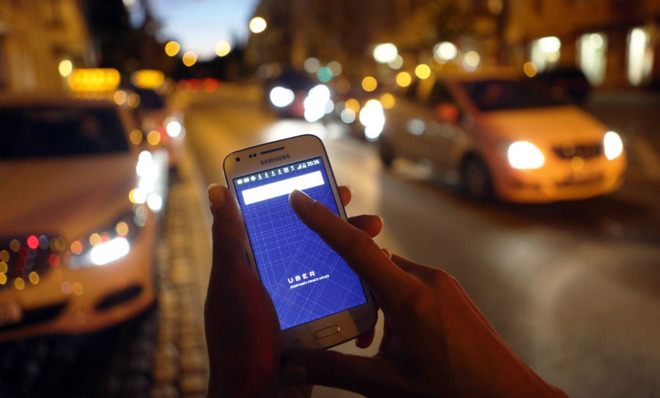The dangerous rise of the temporary technology worker
No, Lyft or Uber drivers are not "their own entrepreneurs"


The conveniences that technology start-ups are bringing us — instant access to cars, groceries, and homes; help cleaning our kitchens — might make our lives simpler, but the same can't be said for a large portion of their employees. Companies like Uber, Lyft, and Homejoy are spending big to subsidize the acquisition of new customers, promoting their brands and giving away discounts for their products. And while it might seem like a great deal for users, it's also creating a new, precarious branch of the labor force in the name of innovation and job-creation.
Take the race to disrupt the taxi industry, for example. Uber and Lyft are competing in the hot contest for market share to make more cars available to more people for more money — some of it flowing to the individual drivers, of course, but with the companies as the main beneficiaries of capital. The two businesses are constantly undercutting each other, offering new deals and better services to customers — but not to their drivers, who form a vital yet underserved part of their business plans.
Several months ago, Lyft launched in Brooklyn, where I live. To promote the service, the company offered riders 50 free rides — as long as the rides were under $25 each and you used up your 50 credits within two weeks of signing up. Though the launch was a little buggy, coasting around the city in free cars was great, and the drivers loved it, too. The initial subsidy meant that the drivers who were early adopters never went without a fare, and users were likely to spend more time and money on the platform than they otherwise would have.
The Week
Escape your echo chamber. Get the facts behind the news, plus analysis from multiple perspectives.

Sign up for The Week's Free Newsletters
From our morning news briefing to a weekly Good News Newsletter, get the best of The Week delivered directly to your inbox.
From our morning news briefing to a weekly Good News Newsletter, get the best of The Week delivered directly to your inbox.
The Lyft honeymoon had the giddy feeling of being given free money for parties on both sides of the user/driver relationship. Several drivers even told me about users who had them start a ride, cancel it when it neared the $25 mark, then restart the cycle while they were still in the car, linking together multiple free trips to cover larger distances. (The app makes spending money frictionless; it also made not spending money frictionless.)
Everything was great. And yet the Lyft drivers were not quite what the company portrayed them as. Lyft and Uber both market themselves in part as a way for amateur drivers to take on taxi work as a kind of wholesome, self-driven small business, like the postindustrial equivalent of selling vegetables out of a home garden. In Brooklyn, where Manhattan's yellow cabs are scarce and private car services dominate the landscape, many of the drivers who jumped to join the new digital workforce were actually those who were already in the market.
In each smartphone-hailed car I've ridden in here, the driver has been juggling a collection of devices that wouldn't look out of place on the desk of a technology company chief executive. There's an iPad emerging from a stand near the shifter, an iPhone with an app running mounted on top of the dashboard, and yet another phone in the driver's hand. One machine is for Lyft, the other for Uber, the last for the car service that likely rents them their car. In my experience, there's no such thing as a pure Lyft driver. Rather than working for a single taxi company, these drivers are hustling between several services that each provides them with just a portion of an income and no stability whatsoever.
This is what Kevin Roose calls Silicon Valley's "contract-worker problem" in New York magazine. "The freelance model is being abused," Roose writes, "with workers being treated as if they were on payroll without getting any of the benefits afforded to payrolled employees." It's also called the "1099 economy" — normal full-time employment practices are being disrupted as more and more workers transition to a time- or commission-based pay scale.
A free daily email with the biggest news stories of the day – and the best features from TheWeek.com
The structure has its benefits, chief among them allowing workers to set their own hours. But in the grand scheme, the optimism with which CEOs approach how they have apparently liberated blue-collar workers is delusional. "We can't tell [drivers] what to do or how to do their job," Steven Hsiao, the CEO of Spoonrocket, a company that delivers fresh-cooked meals to San Francisco residents using contracted drivers, told Roose. "They're their own entrepreneurs."
The comparison is laughable. Entrepreneurship comes with a huge amount of risk and precarity. That's fine when you're buoyed by useful technology skills, experience, and stock holdings, as Hsiao doubtless is. When you're a driver whose "entrepreneurial" endeavor depends on the whims of the companies you're working for — who are themselves backed by unstable venture funding — the benefits of being your own business seem less desirable.
Companies like Uber, Lyft, Homejoy, and Fiverr are platforms for labor the same way Twitter and Tumblr are platforms for content. And both content and labor have become devalued as a result of their growth. While the lack of workforce gatekeepers (in the car case, taxi regulators and medallion vendors) might mean more opportunities for more workers, it's also clear that they drive down the overall price of hiring workers — if not in actual per-hour rates then in the support that companies have traditionally provided to their employees in the form of benefits and stability.
This contract sector of the workforce is also growing faster than ever. Uber's "army of drivers," as described by the Wall Street Journal, is growing by 50,000 new drivers a month. The lack of more regular employment means more workers willing to accept the risk of having to create cash flow for themselves.
The contract system is creating two tiers of tech workers. Developers, designers, and salespeople are fiercely prized by technology companies that compete over talent by inventing new office perks. Yet their disruptive products couldn't function without these small "entrepreneurs" — the drivers and cleaners — who are seen as perfectly disposable. They are hired when the company or customers need them and conveniently disappear when they're unnecessary — perfect for shareholders, bad for the laborers themselves.
In the end, precarity and disposability will always be cheaper. The on-demand economy means getting what you want when you want it, yes, but turn the equation around and it also means that workers only get paid when demand is high enough. Efficient, perhaps, but sustainable or beneficial to the social fabric? Unlikely.
Pacific Standard grapples with the nation's biggest issues by illuminating why we do what we do. For more on the science of society, sign up for its weekly email update or subscribe to its bimonthly print magazine.
More from Pacific Standard...
-
 Did Trump just end the US-Europe alliance?
Did Trump just end the US-Europe alliance?Today's Big Question New US national security policy drops ‘grenade’ on Europe and should serve as ‘the mother of all wake-up calls’
-
 How the War Department became the Department of Defense – and back again
How the War Department became the Department of Defense – and back againIn Depth In 1947 President Harry Truman restructured the US military establishment, breaking with naming tradition
-
 Codeword: December 8, 2025
Codeword: December 8, 2025The daily codeword puzzle from The Week